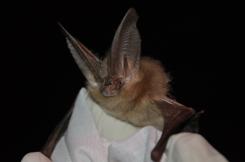Discussion & Conclusions
When should one survey at night?
When to start?
Plecotus auritus and Pipistrellus nathusii had only been observed once each in the occurrence pattern graph and I therefore decided to not include them in my reasoning.
Two speceis started relatively later compared to the others, Vespertilio murinus and Eptesicus nilssonii. In fact, discarding the first observation of V. murinus would make this species start at the same time as E. nilssonii.
Based on my findings it would be appropriate to start when E. nilssonii starts, in other words 25 % into the night. Looking at present recommendations on when to start (see Introduction), which spans from sunset (de Jong & Nord 2005) to one hour after sunset (Gerell & Gerell Lundberg 2003), it would encourage fieldworker to start from 0 % to around 16 % into the night (if an average night is six hours long), which is early compared to the result of my study.
When to stop?
V. murinus was the one to end first, at 70 % into the night, and is also the species, of the most frequently observed ones, that has been observed fewest times. The other species seem to continue their activity (with multiple observations) longer approaching dawn.
Is there a dip in bat activity around midnight?
None of the identified species seem to have a major inactive period (looking at the species occurrence graph), E. nilssonii being the one having the longest “gap” of round 10%. The distribution of observation did not display that there would be a dip-pattern at midnight even if there seem to be a trend of decrease-pattern in the last three nights. These trends however are at different times and of different duration and the values were not great enough for cause a major change in observations, except for the last night. That change, however, was more at the end of night far from the presumed midnight dip.
How does weather affect bats?
In the present study, two factors seemed to affect bats: - species composition, number of observations and at least two species of bats. The negative effects of temperature shown in the present study corroborate the finding of Wolcott & Vulinec (2012), but in contrast to other studies showing positive effect (Johnson et al. 2011; Christie & Simpson 2006; Hayes 1997). Similarly, the positive effect shown by air pressure in the present study corroborates findings by Wolcott & Vulinec (2012) while Johnson et al. (2011) recorded the reversed relationship.
As for the other weather factors there are a lot of differences in litterature which both corroborates and contradicts my findings. The differences may be due to weather one look at individual bat species or overall bats as a group. My result displays that differnt species is affected by different weather factors.
Conclusions
i) The smallest window of opportunity when most bat species are active is between 25 % to 70 % of the night.
ii) There are no major change in bat observations around 24-1 in the night, hence there is no need to stop or pause during the night.
iii) The weather parameters affect species differently but temperature affects both N. noctula and M. daubentonii negative while air pressure affected them positively. Additional investigations is needed to understand the relationships between weather and bats.
References
de Jong J, Nord M (2005) Aktivitetsmönster hos fladdermöss. Unpublished manuscript to the Environmental Protection Agency of Sweden. (Swedish)
Gerell R, Gerell Lundberg K (2003) Övervakning av fladdermöss i Skåne.Environmental Protection Agency of Scania: Malmö. (Swedish)
Wolcott K A, Vulinec K (2012) Bat Activity at Woodland/Farmland Interfaces in Central Delaware. NORTHEASTERN NATURALIST 19: 87-98.
Johnson J. B, Gates J E, Zegre N P (2011) Monitoring seasonal bat activity on a coastal barrier island in Maryland, USA. Environmental Monitoring & Assesments 173: 685-699.
Christie E, Simpson W (2006) Influence of winter weather conditions on lesser short-tailed bat (Mystacina tuberculata) activity in Nothofagus forest, Fiordland. New Zealand Journal of Zoology 33: 133-140.
Hayes J P (1997) Temporal variation in activity of bats and the design of echolocation-monitoring studies. Journal of Mammalogy 78(2): 514-524.
Responsible for this page:
Director of undergraduate studies Biology
Last updated:
05/16/13

